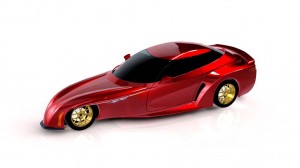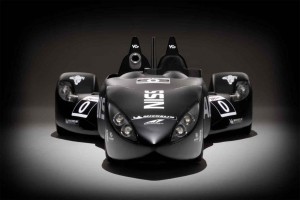
The DeltaWing sedan concept picks up many of the design elements of the race car, notably its sleek aerodynamic shape and light weight.
The radical DeltaWing race car created quite a buzz when it made its debut a few years back, and this equally radical 4-seat passenger car concept is likely to stir things up even more.
Developed by the Georgia-based DeltaWing Technologies, the prototype features a narrow, windswept nose and ultra-light construction to significantly improve fuel economy without sacrificing performance. Whether potential buyers would take to the unusual design remains to be seen, but aerodynamics and “lightweighting” have become critical to the industry’s efforts to meet the tough 54.5 mpg federal fuel economy standards going into effect in 2025.
“Many of the aerodynamic, lightweight and handling benefits of the race car can translate to the street,” said DeltaWing Chairman Don Panoz. “We are competing at the highest levels of road racing with half the weight, half the horsepower, and nearly half of the fuel consumption. We believe we can deliver similar results on the street without compromising safety, comfort and performance. We have a formula that’s highly efficient and still fun to drive.”
Designed by Ben Bowlby and unleashed during the 2011 endurance race in Le Mans, the DeltaWing race car challenged traditional motor sports thinking with its unusual, dart-like design. Initially run in a short-lived partnership with Nissan, the race car was able to run on a much smaller engine than its typical competitor, largely due to the design’s reduced aerodynamic drag.
The basic shape carries over to the street sedan prototype which features smaller front wheels than those in back, while also opting for a rear-engine powertrain layout that shifts the center of gravity significantly to the back to lower weight on those downsized tires while also minimizing rolling resistance.
The Georgia firm claims the design could be used to meet the 2025 Corporate Average Fuel Economy, or CAFE standard, something many in the industry have questioned without the need to significantly downsize the current U.S. automotive fleet.
(From track to street, Click Here to find out how motor sports help improve what we drive.)
Improved aerodynamics are key to the design, but equally important is the use of construction methods and materials – possibly aluminum or carbon fiber – that would mean a 35% reduction in mass compared to a similarly sized vehicle of conventional design.
The payoff, according to DeltaWing would be the ability to use 35% less horsepower without sacrificing performance, with a concurrent 35% increase in fuel economy. The firm says its “current performance targets are 0-60 mph in about six seconds, 130 mph top test-track speed, and up to 70 mpg when using a small displacement, four-cylinder engine producing between 85 and 110 horsepower.”
A statement from DeltaWing claims “Company executives have been meeting with auto manufacturers” to discuss ways to use some of its concepts in a production vehicle.
As for the DeltaWing race car, it is competing this year in the United Sports Car Championship series. Despite its promise and hype, its performance on track has so far failed to live up to expectations.
Nissan, meanwhile, has continued to explore opportunities for a DeltaWing-like design. It revealed a dart-like passenger car prototype late last year and suggested it may have future plans for what it called the BladeGlider Concept.
(Click Herefor a look at the Nissan BladeGlider.)


Wow is that FUGLY.
the federal cafe standards in 2035 require peddles.
Hope this doesn’t go the way of the 3 wheeled ATV …. looks kind of tippy? May want to put some wheels on the running boards :>(